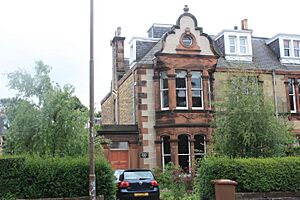James Geikie facts for kids
James Murdoch Geikie (born August 23, 1839 – died March 1, 1915) was a famous Scottish geologist. He was a professor of geology at the Edinburgh University for many years, from 1882 to 1914. He is best known for his studies on the Ice Age and how glaciers shaped the Earth.
Contents
Life Story
Early Life and Learning
James Geikie was born in Edinburgh, Scotland. His father, James Stuart Geikie, was a wig-maker. James had an older brother, Archibald Geikie, who also became a very famous geologist.
James went to the Royal High School in Edinburgh. After school, he first trained to be a printer. But he later decided to study geology at the University of Edinburgh.
His Work as a Geologist
James Geikie worked for the Geological Survey from 1862 to 1882. This job involved mapping and studying the Earth's surface. In 1882, he became a geology professor at the University of Edinburgh. He took over this role from his brother, Archibald.
James was especially interested in how the Earth's surface features were formed. He focused on the powerful role of glaciers and ice in shaping the land. His most important book, The Great Ice Age and its Relation to the Antiquity of Man, was published in 1874. This book explored how ice ages affected the Earth and early humans.
He believed that large sheets of ice on land were the main force behind shaping landscapes. This was different from some other geologists who thought icebergs and floating ice were more important.
In his book Prehistoric Europe (1881), he suggested that there were five warmer periods, called inter-Glacial periods, in Great Britain during the Ice Age. He also argued that some very old human tools (from the palaeolithic period) were found during or before these ice ages, not just after them.
His other books, like Fragments of Earth Lore (1893) and Earth Sculpture (1898), also focused on how the Earth's surface was formed. He also wrote a standard textbook called Outlines of Geology (1886).
Awards and Recognition
James Geikie was recognized by many important scientific groups.
- In 1871, he became a member of the Royal Society of Edinburgh. He later served as its vice-president and then as president.
- In 1875, he was elected a fellow of the Royal Society, which is a very high honor for scientists.
- In 1876, he became a member of the American Philosophical Society.
- He also edited the Scottish Geographical Magazine starting in 1888.
- In 1910, he received the Gold Medal of the Royal Scottish Geographical Society.
- He was president of the Royal Scottish Geographical Society from 1904 to 1910.
Later Life
In his later years, James Geikie lived in a house called "Kilmorie" in Edinburgh. He passed away at home on March 1, 1915. He is buried in Morningside Cemetery in Edinburgh.
A famous American naturalist, John Muir, named a glacier in Alaska after James Geikie to honor his work.
See also
- Ordnance Gazetteer of Scotland: A Graphic and Accurate Description of Every Place in Scotland (James Geikie wrote the section about Scotland's main physical features in this book).



